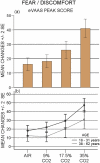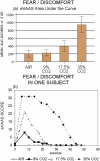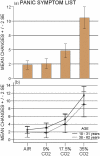Carbon dioxide inhalation induces dose-dependent and age-related negative affectivity
- PMID: 17912364
- PMCID: PMC1991589
- DOI: 10.1371/journal.pone.0000987
Carbon dioxide inhalation induces dose-dependent and age-related negative affectivity
Abstract
Background: Carbon dioxide inhalation is known to induce an emotion similar to spontaneous panic in Panic Disorder patients. The affective response to carbon dioxide in healthy subjects was not clearly characterized yet.
Methodology/principal findings: Sixty-four healthy subjects underwent a double inhalation of four mixtures containing respectively 0, 9, 17.5 and 35% CO(2) in compressed air, following a double blind, cross-over, randomized design. Affective responses were assessed according to DSM IV criteria for panic, using an Electronic Visual Analogue Scale and the Panic Symptom List. It was demonstrated that carbon dioxide challenges induced a dose dependent negative affect (p<0.0001). This affect was semantically identical to the DSM IV definition of panic. Older individuals were subjectively less sensitive to Carbon Dioxide (p<0.05).
Conclusions/significance: CO(2) induced affectivity may lay on a continuum with pathological panic attacks. Consistent with earlier suggestions that panic is a false biological alarm, the affective response to CO(2) may be part of a protective system triggered by suffocation and acute metabolic distress.
Conflict of interest statement
Figures





Similar articles
-
Double-blind acute clonazepam vs. placebo in carbon dioxide-induced panic attacks.Psychiatry Res. 2000 May 15;94(2):179-84. doi: 10.1016/s0165-1781(00)00135-9. Psychiatry Res. 2000. PMID: 10808043 Clinical Trial.
-
Carbon dioxide-induced emotion and respiratory symptoms in healthy volunteers.Neuropsychopharmacology. 2008 Dec;33(13):3103-10. doi: 10.1038/npp.2008.31. Epub 2008 Mar 19. Neuropsychopharmacology. 2008. PMID: 18354390 Clinical Trial.
-
Carbon dioxide induced panic attacks and short term clonazepam treatment. Preliminary study.Arq Neuropsiquiatr. 1999 Jun;57(2B):361-5. doi: 10.1590/s0004-282x1999000300003. Arq Neuropsiquiatr. 1999. PMID: 10450339 Clinical Trial.
-
Experimental pathophysiology of panic.J Psychosom Res. 1998 Dec;45(6):493-503. doi: 10.1016/s0022-3999(98)00027-0. J Psychosom Res. 1998. PMID: 9859852 Review.
-
[A Meta-Analysis of Efficacy of Carbon Dioxide Inhalation as a Challenge Test in Panic Disorder].Turk Psikiyatri Derg. 2019 Summer;30(2):99-108. Turk Psikiyatri Derg. 2019. PMID: 31487375 Turkish.
Cited by
-
Effect of serotonin transporter genotype on carbon dioxide-induced fear-related behavior in mice.J Psychopharmacol. 2020 Dec;34(12):1408-1417. doi: 10.1177/0269881120959611. Epub 2020 Oct 24. J Psychopharmacol. 2020. PMID: 33103571 Free PMC article.
-
Neuroimmune mechanisms in fear and panic pathophysiology.Front Psychiatry. 2022 Nov 29;13:1015349. doi: 10.3389/fpsyt.2022.1015349. eCollection 2022. Front Psychiatry. 2022. PMID: 36523875 Free PMC article. Review.
-
Evidence for consistent individual differences in rat sensitivity to carbon dioxide.PLoS One. 2019 Apr 24;14(4):e0215808. doi: 10.1371/journal.pone.0215808. eCollection 2019. PLoS One. 2019. PMID: 31017958 Free PMC article.
-
Lifelong opioidergic vulnerability through early life separation: a recent extension of the false suffocation alarm theory of panic disorder.Neurosci Biobehav Rev. 2014 Oct;46 Pt 3:345-51. doi: 10.1016/j.neubiorev.2014.03.025. Epub 2014 Apr 13. Neurosci Biobehav Rev. 2014. PMID: 24726574 Free PMC article. Review.
-
Effects of tryptophan depletion and tryptophan loading on the affective response to high-dose CO2 challenge in healthy volunteers.Psychopharmacology (Berl). 2011 Jun;215(4):739-48. doi: 10.1007/s00213-011-2177-8. Epub 2011 Feb 19. Psychopharmacology (Berl). 2011. PMID: 21336580 Free PMC article. Clinical Trial.
References
-
- Papp LA, Martinez JM, Klein DF, Coplan JD, Norman RG, et al. Respiratory psychophysiology of panic disorder: three respiratory challenges in 98 subjects. Am J Psychiatry. 1997;154:1557–1565. - PubMed
-
- Griez E, Schruers K. Experimental pathophysiology of panic. J Psychosom Res. 1998;45:493–503. - PubMed
-
- Coryell W, Pine D, Fyer A, Klein D. Anxiety responses to CO2 inhalation in subjects at high-risk for panic disorder. J Affect Disord. 2006;92:63–70. - PubMed
-
- Coryell W. Hypersensitivity to carbon dioxide as a disease-specific trait marker. Biol Psychiatry. 1997;41:259–263. - PubMed
-
- Klein DF. False suffocation alarms, spontaneous panics, and related conditions. An integrative hypothesis. Arch Gen Psychiatry. 1993;50:306–317. - PubMed
Publication types
MeSH terms
Substances
LinkOut - more resources
Full Text Sources
Medical

